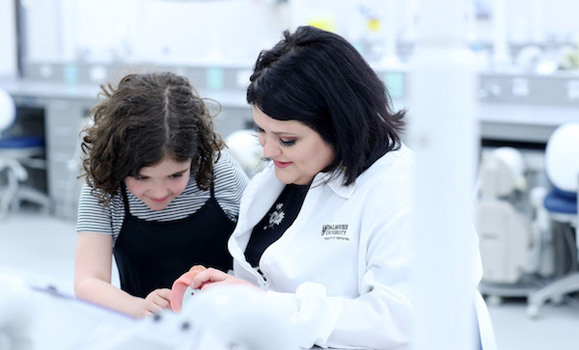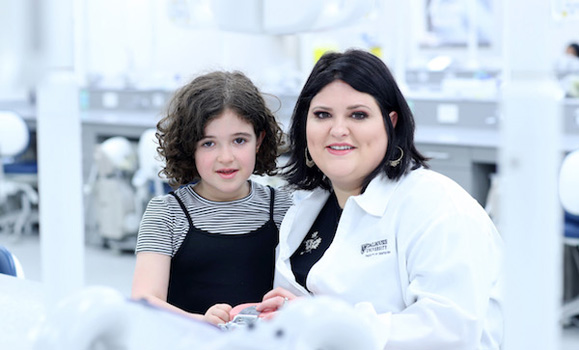Marilyn Harris (DDH’07, BDH’19) had it all: a job she loved, a husband and young daughter, her parents living nearby, and a bucolic life in Seven Mile Bay, PEI, where she and her family enjoy a lovely view of Confederation Bridge. And then a workplace injury changed everything.
When several surgeries couldn’t give her back her old life, Marilyn decided to change her life.
Marilyn had been working at Kensington Dental Clinic for seven years when she noticed that she was having trouble with her hands. She was experiencing pain, numbness, and tingling in her arms and hands. She sometimes dropped instruments.
“I didn’t notice what was happening at first,” says Marilyn, “but it had a cumulative impact. When I went to see my doctor, I was diagnosed with bilateral severe carpal tunnel syndrome.”
Marilyn had surgeries on both hands. These were followed by surgeries for the De Quervain’s tenosynovitis (inflammation of the tendons) in her wrists. She had three different surgeons: two in Prince Edward Island and one in Nova Scotia.
The surgeries improved Marilyn’s condition, but she was left with numbness in her thumb and she didn’t recover her full pinch and grip strength. It was at this point Marilyn realized she would not be able to continue to work as a dental hygienist.
The return to university and the BDH program
With a mixture of excitement and trepidation, she applied to return to the Faculty of Dentistry to study for a bachelor of dental hygiene (BDH). “I thought it could open up doors to a master’s degree or help me branch out in other directions,” says Marilyn.
She was accepted into the program and then came the really tough step. Marilyn had to move to Halifax, spend long stretches away from her family, and learn how to manage her time in a whole new way. Many weekends would be spent travelling back and forth to PEI.
Marilyn’s husband, Nick, and seven-year-old daughter Sadie stayed in PEI when Marilyn made the move to Halifax. She credits their support, and the backup from her parents, with enabling her to return to university. Â
At age 34, Marilyn joined a class of nine BDH students, six of whom were newly graduated from the diploma program. It was daunting to begin with.
Whereas the dental hygiene diploma program focuses on oral health education and acquiring and perfecting basic skills in dental hygiene, the bachelor program is more about research, participating in different outreach clinics – schools, hospitals, disadvantaged youth – and teaching.
The year was one of “personal growth and learning” for Marilyn. It was also challenging being apart from her family. “I felt like I wasn’t contributing at home,” she says. Plus, she missed key events in her daughter’s life, like the first day of school, dance classes, report cards, or a tough day.
Support from home, fellow students, and faculty at HÂţ» helped her to keep going.
 Marilyn and her daughter, Sadie
Marilyn and her daughter, Sadie
Discovering what mattered
When she began to dive deeper into her program, things started to come together for Marilyn. As part of Teaching Methodologies and Practicum with Prof. Denise Zwicker, Marilyn had an opportunity to give a presentation on a topic of interest. She chose occupational injuries.
Marilyn approached Karen Joudrey, an instructor in the School of Occupational Therapy at Dal who specializes in disability management, and asked if she would be willing to collaborate. She was. Together they co-taught a first-year class on the importance of awareness, prevention, good body mechanics, and gave the students some stretching exercises aimed at preventing injuries.
“I don’t think people understand how physical the job is and its impact on your body,” says Marilyn. “My experiences made me much more interested in injury prevention and disability management.”
After her teaching experience, Marilyn talked to Prof. Zwicker and Karen Joudrey about forming a collaboration between the Schools of Occupational Therapy and Dental Hygiene. As a result, occupational therapy (OT) students with the @WORK project (formerly WorkSAFE@Dal) observed first-year dental hygiene students caring for patients in the clinic and made recommendations for improving postures and clinic work spaces.
“I’m proud of this work,” says Marilyn, “and I hope it will continue to grow and reduce the number of injuries for others.”
Marilyn also had the opportunity to explore her interest in workplace injuries in an applied research course, taught by Dr. Martha Smith Brillant. For this course, Marilyn and fellow classmate Savanna Sentner, created a two-part research project: a survey on musculoskeletal injuries among dental hygienists that was distributed by the Canadian Dental Hygienists Association (CDHA), and an interview with accredited dental hygiene schools about how they teach ergonomics and injury prevention. Marilyn and Savanna’s research paper, which contains several recommendations, will be presented at the CDHA’s national conference in St. John’s, NL, October 3-5, 2019, and is being submitted to the Canadian Journal of Dental Hygiene to be considered for publication.
If it had not been for her injury, Marilyn admits that she would have been satisfied to continue working as a dental hygienist and not pursue the bachelor’s degree.
“When I was young and healthy, I didn’t see the bachelor program as important. I didn’t really plan for my future. In my case, it was an injury that made me reassess my career, but it could be something else. The BDH program gives you a lot more flexibility and I really enjoyed my year. I’ve become the program’s biggest promoter!”
Looking ahead
Marilyn isn’t sure what the future holds for her. At the moment, she is working with Health PEI as part of the Wellness and Safety team. She is also taking an online course in disability management with Pacific Coast University for Workplace Health Sciences.
“I’m very passionate about doing something in the area of workplace injuries and disability management and to help others to be proactive and prevent injuries. I never imagined that I could be injured doing my job, but it can happen.”


